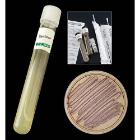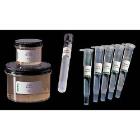You Searched For:
43 results were found
California
Description:
Frequent human isolate. Causes gastroenteritis.
Description:
Isolated from human urinary tract and wound infections, this organism is identifiable by its characteristic putrefactive odor.
Description:
Isolated from soil. Forms red pigment (best on high carbohydrate medium) and has oval eccentric spores.
Catalog Number:
(470180-138)
Description:
Lives in intestine of host — mealworms — as symbiotic organism. Culture of mealworms provided.
Catalog Number:
(470176-630)
Description:
Eudorina (Small)
Catalog Number:
(470179-720)
Description:
Carteria (Small)
Catalog Number:
(470177-296)
Description:
Fucus Macroalgae (Small)
Catalog Number:
(470179-760)
Description:
Dunaliella (Small)
Description:
This pathogenic organism is sometimes isolated from hay and grass.
Description:
Both of these strains of Serratia marcescens are colorless mutants when plated alone, but when grown together, they produce a red pigment.
Description:
Ames test strain for detecting carcinogens. Causes infection in humans.
Description:
This organism is occasionally isolated from soil, but most frequently from smegma- a secretion from male and female genitalia.
Description:
This organism can be isolated from soil, wounds, and intestinal tracts of humans. It digests protein and is known for its strong, distinctive odor.
Catalog Number:
(470179-206)
Description:
All microbial cultures undergo an extensive quality control program prior to releasing for sale, so they are guaranteed for purity as well as for spec...
Description:
Beta hemolysis on blood. Causes wound infections and septicemia.
Catalog Number:
(470179-164)
Description:
Isolated from milk and udders of cows. Lancefield group B, beta hemolysis. Causes infection of the female genital tract, maternal septicemia, neonatal...
Inquire for Price
Stock for this item is limited, but may be available in a warehouse close to you. Please make sure that you are logged in to the site so that available stock can be displayed. If the
Stock for this item is limited, but may be available in a warehouse close to you. Please make sure that you are logged in to the site so that available stock can be displayed. If the
This product is marked as restricted and can only be purchased by approved Shipping Accounts. To apply for a shipping account number, click here. If you need further assistance, call Customer Service at 800-962-2660 or email [email protected].
-Additional Documentation May be needed to purchase this item. A VWR representative will contact you if needed.
This product has been blocked by your organization. Please contact your purchasing department for more information.
The original product is no longer available. The replacement shown is available.
Limited quantities of this product are available. To check availability or place an order, call Customer Service at 800-962-2660 or email [email protected].
|
|||||||||













